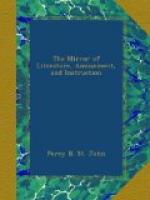It is somewhat surprising, that among the crowd of novelties, and very especially of attempts to depart from the received models of architecture, the Egyptian has not taken its share. It is true that some very partial attempts have been made; in the metropolis, we believe, not exceeding two; and if we add to these a school recently erected at Devonport, a mausoleum at Trentham for the Stafford family, and an iron-manufactory now erecting in Wales, we have probably enumerated the whole. Such as the examples have been, they have not spread; and, indeed, we may say, that they have scarcely attracted any notice, whether for good or evil; though the publicity and singularity of aspect of the most accessible specimen in Piccadilly might have at least been expected to distinguish it, in the general eye, from the buildings by which it is surrounded. As to the public, we find no difficulty in accounting for this. This style has not been pointed out to them, and they have not been desired either to admire or dislike it. Why the architects have neglected it, they must themselves explain, since we believe there have been but two in that profession who have been concerned with the buildings to which we have alluded, the last named of these being an attempt of a dillettante in the art. As to the specimens where it has been thought fit to introduce the Egyptian window or doorway in churches of a Greek design, we consider the attempt faulty and censurable. This is a false and misplaced ambition after novelty, which marks far too much of what has recently been effected in our new churches.—Westminster Review.
Coinage.
Coins are generally completed by one blow of the coining-press. These presses are worked in the Royal Mint by machinery, so contrived that they shall strike, upon an average, 60 blows in a minute; the blank piece, previously properly prepared and annealed, being placed between the dies by part of the same mechanism. The number of pieces which may be struck by a single die of good steel, properly hardened and duly tempered, not unfrequently amounts at the Mint to between 3 and 400,000. There are eight presses at the Mint, frequently at work ten hours a day, each press producing 3,600 pieces per hour; but making allowance for occasional stoppages, the daily progress of each press may be reckoned at 30,000 pieces; the eight presses, therefore, will furnish a diurnal average of 240,000 pieces.—Quarterly Journal.
The Ornithorynous.
This remarkable animal, which forms the link between the bird and beast, has a bill like a duck, and paws webbed similar to that bird, but legs and body like those of a quadruped, covered with thick, coarse hair, with a broad tail to steer by. It abounds in the rivers of New Holland, and may be seen bobbing to the top every now and then, to breathe, like a seal, then diving again in quest of its prey. It is believed to lay eggs, as a nest with eggs in it of a peculiar appearance was some time ago found. It bears a claw on the inside of its foot, having a tube therein, through which it emits a poisonous fluid into the wounds which the claw inflicts; as, when assailed, it strikes its paws together, and fastens upon its enemy like a crab.—Cunningham’s New South Wales.




